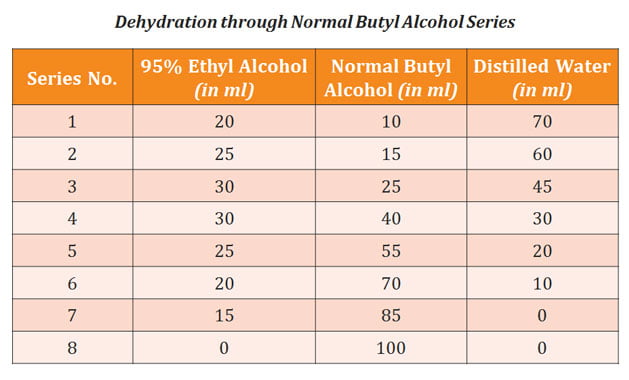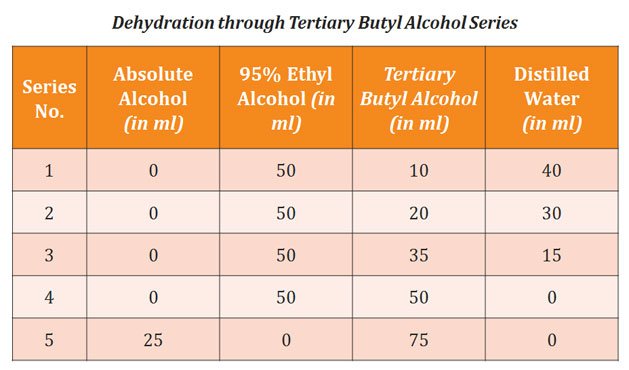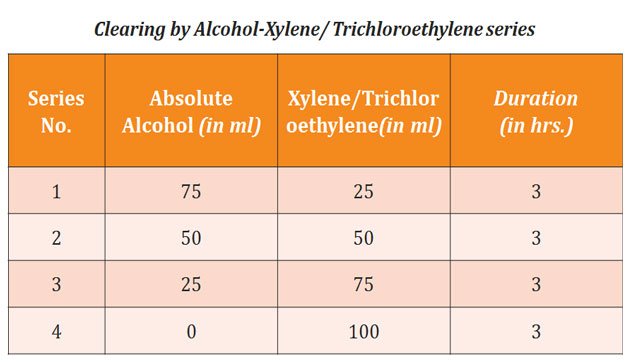In histology and histopathology, dehydration is a crucial step in the preparation of tissue specimens for microscopic examination. Dehydration is the process of removing water from the tissue by using a series of graded alcohols before embedding it in a medium that can be sliced thinly for microscopic examination. The purpose of dehydration is to replace the water in the tissue with a medium that is compatible with the embedding medium, which is usually a wax or a resin. The present post discusses the processes of dehydration in histopathology.
Learning objectives: Dehydration: definition, importance; General account of dehydration; Reagents used for dehydration: Ethanol, Isopropyl alcohol, Acetone, Glycerine; Process of dehydration; Ethanol – Xylene series; Tertiary Butyl Alcohol Series; Clearing – Purpose of Clearing, Reagents for Clearing and Techniques of Clearing
What is dehydration?
Ø Water is present in the cells. Water from the cells should be removed for the permanent slide preparations, because:-
$. Water will decay the specimen.
$. Water is not miscible with paraffin wax used for embedding.
$. Water will not mix with the usual media of staining.
$. What is not miscible with permanent mountant.
Ø Dehydration: “The process of removal of water from biological samples before impregnation or final mounting is called dehydration”
Ø Dehydrant: The reagent used for dehydration is called dehydrant.
Dehydration in Histopathology
Ø Dehydration of the biological specimens cannot be done quickly, it should be done gradually.
Ø The dehydration is done by treating the material with a series of solutions containing progressively decreasing concentrations of water and a progressively increasing concentration of dehydrant.
Ø Specimens are kept in the dehydrant for specific time interval.
Ø The time interval is determined by the size and nature of the specimen.
Ø Long interval in low concentration makes tissue soft.
Ø Long interval in high concentration makes tissue brittle.
Ø Dehydrating reagents are changed by decanting from the material.
Ø After decanting, specimens are immediately filled with next grade fluid.
Ø Materials should not be dried at any stage.
Dehydrants (Reagents used for Dehydration)
Ø Many reagents are used for the dehydration of plant specimens.
Ø Some reagents are just water removing agents, whereas some others are both water removing and suitable for subsequent processing.
Ø Commonly used dehydrating reagents are:
- Ethyl alcohol /Isopropyl alcohol
- Acetone
- Glycerin (glycerol)
- Tertiary butyl alcohol (TBA)
- Dioxan
(1). Ethyl Alcohol / Isopropyl Alcohol
Ø Ethanol is the most commonly used dehydrating reagent.
Ø Isopropyl alcohol can be used exactly in the same manner as ethyl alcohol.
Ø A series of alcoholic percentage solutions are prepared in water.
Ø Concentrations required: 5, 10, 15, 20, 25, 30, 35, 40, 50, 60, 70, 80 and 95
Ø The final reagent will be 100% alcohol (absolute alcohol)
Ø Incubation time:
$. 30 minutes for delicate materials like roots, young stem and 12 hours for large blocks up to 70%
$. 60 minutes in 80 and 95% solutions
$. 24 hours in 100% solution
(2). Acetone
Ø Percentage solution series of acetone is to be prepared in water.
Ø Concentrations (in %): 7.5, 10, 15, 20, 25, 30, 35, 40, 60, 70, 80, 90 and 100.
Ø Incubation time: ~ 1 hour in each concentration.
Ø The procedure is exactly similar to that of ethyl alcohol
(3). Glycerin (Glycerol)
Ø Glycerin is an excellent material for dehydrating delicate materials such as algae and fungi.
Ø Glycerin has a high boiling point (290oC).
Ø Thus, the water can be removed by evaporation.
Ø The major problem with glycerin is that it causes plasmolysis of cells.
Ø To avoid plasmolysis, the treatment should be gradual and slow.
Dehydration with glycerin (glycerol)
$. Wash the material in water to remove the fixative.
$. Material is transferred to 5% glycerin (in water) in a wide-mouthed jar.
$. Leave this jar open until the water evaporates.
$. Evaporation of water can be hastened by keeping the jar in an over (35oC)
$. Setup should be in a dust-free environment.
$. After a nearly anhydrous condition is reached, give a change of pure glycerin.
$. Proceed to the next step of micro-technique directly.
Dehydration through Normal Butyl Alcohol Series

Dehydration through Tertiary Butyl Alcohol Series
What is clearing?
Ø The clearing is the process of removal of dehydrant from the specimen.
Ø Clearing: The transfer of materials after dehydration in the reagents that are not solvents of wax (like ethyl or isopropyl alcohol) to solvents of wax.
Ø Clearant: The reagent used in the clearing is called clearant or clearing agent.
Ø Clearing is also called as dealcoholization (if alcohol is used as the dehydrant).
Ø Clearing is not an essential step. The clearing become necessary when materials are dehydrated in reagents that are not miscible with wax (used for embedding) or resinous embedding media (used for permanent mounting).
Reagents used in clearing
Commonly used reagents in the clearing are:
1. Xylene (xylol)
2. Trichloroethylene
3. Chloroform
4. Benzene
(1). Xylene
Ø Most commonly used clearing agent for the botanical specimen.
Ø Xylene is miscible with paraffin wax and alcohol.
Ø It is not miscible with water.
Ø The clearing is done by a graded series of clearant and dehydrant.
Ø Increasing concentration of clearant and decreasing concentration of dehydrant is used.
Ø Trichloroethylene can be used exactly as xylene.
Clearing by Alcohol-Xylene/ Trichloroethylene series
<<< Back to MICROTECHNIQUE Notes
You might also like…
@. Sectioning


